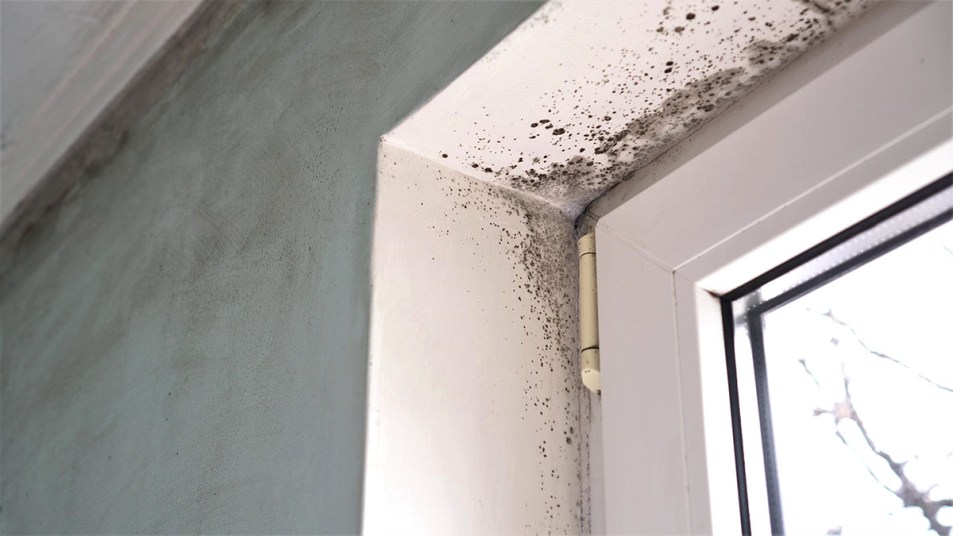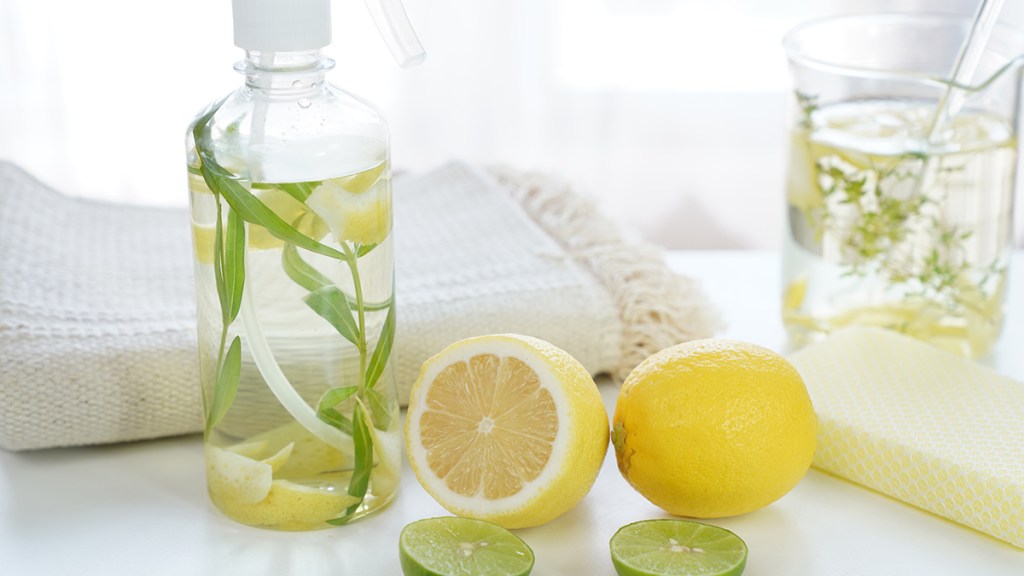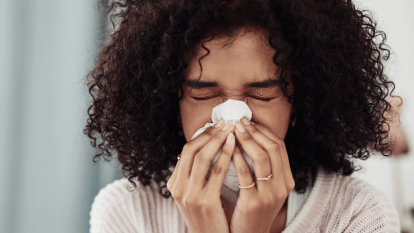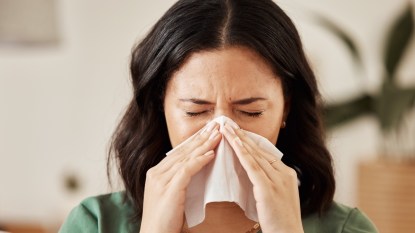Mold Has Been Shown To Trigger Tiredness + Mood Swings — And Fall Is Peak Mold Season
Jill Carnahan, MD, estimates that reaction to mold plays a role in 75% of the patients she treats

If feeling fatigued, foggy and out of sorts has become your new normal, you could be one of the millions of women suffering from neurological symptoms of exposure to mold and the mycotoxins it produces. In fact, functional medicine expert Jill Carnhahan, MD, estimates that mycotoxins, toxic substances produced by mold, play a draining role in up to 75% of patients she treats. Findings in the journal Safety and Health at Work confirm her observations, revealing that exposure to mycotoxins increases risk of fatigue by 344%. Study authors also determined that people exposed to mold were two-and-a-half times more likely to suffer from respiratory problems. Plus, they were nearly five times as likely to experience neurological symptoms of mold exposure such as brain fog and dizziness.
Fortunately, taking steps to eliminate mold and reduce your exposure can end tiredness and significantly improve energy levels. Read on to learn where mold is lurking and how to conquer it, then see how Tania Dempsey, MD, did exactly that and restored her health.
The physiological effects of mold exposure
In a recent study of almost 5,000 American adults, 15% reported indoor mildew odor or musty smell in their households. People who reported indoor mildew odor or musty smell also reported poorer self-rated health, sleep complaints, chronic bronchitis, asthma attack, itchy rash, sneezing and poor vision. And that’s just from exposure to a mildewy smell. Exposure to actual toxins produced by mold has ‘devastating consequences’ for millions of women, says Jessica Jellison, MD, cofounder of Jellison Integrative MD in Overland Park, Kansas. “These mycotoxins damage cell membranes, impairing their ability to generate energy,” she explains. Plus, Taz Bhatia MD, author of The Hormone Shift, points out, “Mycotoxins trigger an inflammatory response that wreaks havoc on the immune, nervous and digestive systems. Dr. Carnahan adds that mycotoxins also disrupt thyroid and adrenal gland function. The result: Symptoms such as brain fog, muscle weakness and fatigue. (Click through to see how hidden mold has also been linked to weight gain.)
The neurological symptoms of mold exposure
Human exposure to molds, mycotoxins, and water-damaged buildings can cause a wide range of neurologic and neuropsychiatric signs and symptoms, including unexplained pain, movement disorders, light-headedness, problems with balance and even dementia. In a study of mice, researchers found a marked increase in memory problems and anxiety in those that were exposed to mycotoxins.
In a study of 105 adults exposed to mold compared to 202 adults not exposed to mold, researchers found that those exposed exhibited decreased balance, longer reaction times, increased color discrimination errors, decreased visual field, and reduced grip strength.
Mold exposure has also been linked to a higher incidence of depression. In an analysis of date related to Europeans, researchers found that roughly 40% of the residents lived in visibly damp, moldy households, and overall their risk for depression averaged 34–44% higher than that for residents of mold-free dwellings. In other research, exposure to mycotoxins was associated with with the worsening of neurodegenerative diseases, like Parkinson’s disease and Alzheimer’s disease.
Most famously, mold toxins can trigger outsized emotional reactions so severe, they’ve been dubbed ‘mold rage.’ “Mold exposure can absolutely affect the brain to cause dramatic mood changes and trigger anxiety, irritability, anger and aggression,” Dr. Carnahan notes. Indeed, in a study in Toxicology and Industrial Health, participants who had been consistently exposed to mold tested 92% higher on anger measurements than those who weren’t exposed.
Mold is hiding in plain sight
Water-damaged buildings are well-known hazards that harbor high levels of mold. But household mold can lurk in damp areas in households even when water damage isn’t present. In fact, in a study published in the Journal of Occupational health and Hygiene, researchers found mold hotspots in every home they tested. Outdoors, mold thrives in damp, dark places, like in piles of leaves and in gardens. In many areas of the country it’s worse in the fall. Another way mycotoxins gain access to the body is through foods that harbor mold, such as nuts, grains, cheese and coffee. That’s a problem, since Tufts University research reveals even low levels of exposure to mycotoxins can trigger toxicity.
How to tell if mold is causing your neurological symptoms
Doctors can conduct blood and urine tests to determine whether mycotoxins are causing your fatigue, brain fog and other neurological symptoms. But for a screening test you can do yourself, Dr. Carnahan advises taking a Visual Contrast Sensitivity Test (free at VCStest.com). “It doesn’t differentiate between damage done by mycotoxins and other problems like heavy metals or Lyme disease, but it’s helpful in guiding treatment and tracking progress during recovery,” she says.
How to outsmart neurological symptoms of mold exposure
If the tests above indicate that you’re dealing with toxicity, the following strategies can help minimize mold and leave you energized:
To eliminate household mold: Clean with this kitchen staple

Dr. Taz advises cleaning mold-prone areas such as showerheads, stalls and bathtubs with white vinegar. In a study published in the International Journal of Environmental Research and Public Health, vinegar was shown to inhibit mold growth. And since findings in the journal Environmental DNA reveal sink drains are hidden mold hotspots flush them with ½ cup of baking soda and 1 cup of white vinegar weekly. (Click through to learn why you don’t want to clean mold with baking soda and bleach and for info on another mold hotspot: memory foam mattresses.)
For help in assessing and removing more extensive mold growth caused by flooding, plumbing leaks or roof leaks, surf to NORMIpro.com to find a certified mold professional near you.
To lower mycotoxin levels: Make easy diet tweaks

Cutting out foods that harbor mold can reduce your toxic burden, says Dr. Jellison. She advises avoiding top sources such as corn, wheat, peanuts, cashews and sugar cane. Also smart: Enjoying sulfur-rich foods such as broccoli, Brussels sprout, kale and garlic. “Sulfur compounds restore the liver’s detoxifying ability and protect cells against mycotoxin damage,” Dr. Carnahan explains. For another tasty way to sidestep mycotoxins, opt for frozen berries. “Berries are frozen within hours of being picked, which keeps the risk of mold contamination low,” says Bill Rawls, M.D., author of Suffered Long Enough.
To speed elimination: Consider toxin-taming supplements
Dr. Carnahan recommends taking GI Detox by Bio Botanical Research (buy on Biocidin.com for $32.47) twice daily. It contains ingredients such as natural clay and activated charcoal that bind to toxins in the gut. In addition, she recommends pairing it with 1,000 mg. of Bulletproof Coconut Charcoal (buy on Amazon for $18.89). “It works in combination with other binders to optimize toxin removal,” she says. “It’s especially good to take before eating foods that may harbor mycotoxins.”
Mold toxicity success story: Tania Dempsey, MD

“Why do I feel like I just ran a marathon?” wondered Tania Dempsey, MD, 52, collapsing in her office chair at 6 pm after seeing her last patient of the day. “My body was exhausted and my feet were so swollen that the shoes I’d slipped on that morning were too tight to wear home. So many people relied on me: my patients, my staff, my family — but I feared, It’s getting hard to function while feeling this bad.
Tania was trapped in her own medical mystery
“A few years ago, I was in my best health, running 25 miles a week and managing my own medical practice, AIM Center For Personalized Medicine, where I literally treated patients who had chronic, mystery illnesses. I never thought I’d be one. I practiced what I preached: diet, exercise, meditation. I thought I had all my ducks in a row.
“Then I noticed some symptoms popping up. It was hard to wake up in the mornings, but nothing compared to how drained I felt each afternoon as I battled headaches and brain fog. I was a pusher — always pushing myself to get things done. Somehow I slogged through, knowing that everyone depended on me.
“Then one day, I noticed my legs were swelling. As it continued, I worried I had developed a heart condition, so I got evaluated: all normal. When I gained 10 pounds in two weeks, I wondered about an endocrine problem. Again, everything checked out. To my frustration, I packed on another 20 pounds even though I hadn’t changed my routine. Despite what experts said, I knew something wasn’t right.
How Tania discovered the true cause of her symptoms
“My symptoms worsened and I developed shortness of breath. I wondered if I was fighting a bug, something one of my three kids brought home from school. One thing was clear: My body was really struggling. “I tracked my symptoms and noticed I felt worse on workdays. That’s when I had to consider the one thing I couldn’t control about my health: my environment. I thought back…two years earlier, there had been a leaky roof that caused some water damage above my office. It had been patched, but perhaps not as thoroughly as needed. I asked around about it, but people said my symptoms were ‘all in my head.’ “Around this time, I noticed some water damage in my basement. When one of my kids started displaying the same symptoms as me, I just knew: mold exposure!
“I reached out to a colleague who specialized in this issue, and a urine test confirmed I had mold mycotoxins in my body. Next, I had a mold specialist test my environment, who found high levels of aspergillus in the HVAC system, plus stachybotrys and trichothecene mycotoxins in a closet.
“I knew the first step in my recovery would be removing myself from the mold. So while my home was being cleaned, my family found a temporary place to stay. I quickly noticed a 25% improvement in symptoms by just getting into a new space and limiting my exposure. Michael Rubino, owner of the remediation company Home Cleanse, told me, ‘If there’s one pattern that’s become apparent to me after 10 years of this work, when we pay more attention to our air quality, we promote better health.’ That’s so true.
How Tania detoxed her body and restored her health
“Next, I started to detox my body using vitamin D and methylated B-12, plus other supplements, including the antioxidant glutathione, the amino acid N-acetylcysteine and the flavonoid quercetin. (Keep reading here about all the health benefits of quercetin and how glutathione benefits the body and mind.) I also used binders like activated charcoal to optimize toxin removal. (Click through to see how to make activated charcoal smoothies.) And I also found that sitting in an infrared sauna helped.
“Each month, I felt more energized and clearheaded. Complete recovery took about a year since my immune system had been so compromised, but I was grateful for every improvement.
“This experience made me a better doctor. I learned firsthand how different molds can affect people in different ways, making it tricky to treat. My husband wasn’t affected, whereas my system became totally overwhelmed. I’ve since done genetic testing to learn that I’m prone to fungal infections and mold sensitivity. I now know there isn’t a one-size-fits-all remedy, so whenever I treat a patient now, I take a comprehensive approach.
“Today, I’m happy to say, I’m back! Back to enjoying my full, busy life. I stay vigilant: making sure my home is adequately ventilated, humidity is controlled and no mold is collecting in the rubber gasket of my front-loader washing machine (a common hiding place.) My advice to women: Trust your gut. You know your body better than anyone else!”
A version of this article originally appeared in our print magazine, First for Women.
This content is not a substitute for professional medical advice or diagnosis. Always consult your physician before pursuing any treatment plan.
For more ways to eliminate mold from your home:
PhD: There’s More Mold on Windowsills Than Anywhere Else in Your Home
MDs Warn: Your Air Conditioning Could Be Harboring and Recirculating Mold + Bacteria
The Reason You Can’t Get Rid of ‘Pink Mold’ Is That It’s Actually a Bacterium













